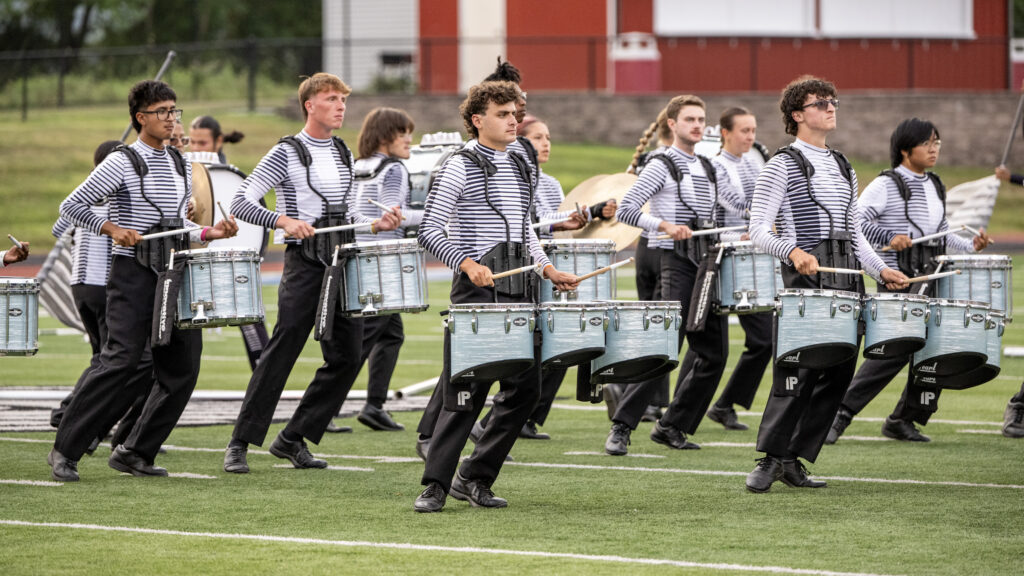In 2018, Mandarins arrived.
The Sacramento, California corps made significant organizational strides throughout the mid 2010s, and nearly put it all together in 2017.
But 2018 was the year that went down in history — after 55 years of history and tradition, for the first time ever, Mandarins landed among the Top 12, as a Drum Corps International World Class finalist.
And Mandarins “didn’t just knock politely” into Finals, either, as then-executive director Jim Tabuchi said in a post-performance pep talk.
They “absolutely kicked the door down.”
“If anybody thought, for some silly reason, you didn’t belong,” corps director J.W. Koester said in addressing the corps following its Semifinals performance, “I’m pretty darn sure you closed the door on that thought.”
The vehicle that helped lead Mandarins to the “promised land” was rich with visual innovation and creative license.
Titled, “Life Rite After,” it told an epilogue of the lead dancer in Igor Stravinsky’s popular-yet-controversial ballet, “Rite of Spring,” who famously “dances herself to death” within the production.
“Back in my day, right, I would’ve had a cassette tape, and I would’ve kept rewinding it and rewinding it because there was something else that I wanted to hear,” Tabuchi said of the corps’ 2018 production. “There is a tremendous amount of layering that happens, to the level where each individual out there is a character.”
Riding a wave of building competitive success, Mandarins wrote multiple brand-new stories in 2018, picking up where Stravinsky — and the corps that came before it — left off.
2018 Mandarins | “Life Rite After”
10th place, 88.150
The first thing to know about “Life Rite After” was its unique staging — or, more accurately, its unique stage.
For the corps’ 2018 production, Mandarins built a circular stage that spanned from 45-yard line to 45-yard line, and used hydraulic technology to rotate. The 6,000-pound prop piece served as the epicenter of Mandarins’ program.
The opening scene featured the “corps proper” members — who were dressed in black and dark purple — lining the front sideline. In this moment, they were meant to represent “Rite of Spring” audience members, looking on as a singular ballet dancer, dressed all in white, took the stage and performed what was meant to symbolize the end of Stravinsky’s ballet. This dancer would serve as the show’s focal character.
As she danced, narration echoed, featuring the presumed voice of Igor Stravisnky, explaining the scene. “The sacrificial virgin,” he said, “dances herself to death.” With this moment, the front ensemble kicked in with recognizable passages from “Rite of Spring,” all building to the dancer’s dying moment.
Set to the background music of a mysterious, brooding trombone choir, the main character was quickly changed into an outfit that matched that of her fellow color guard members, who all slowly entered the field. Each wore a black and red body suit, with black headgear featuring a handful of spikes sticking out of the top.
It appeared, in this moment, as though the main character was entering into some sort of underworld.
Finally, after nearly two full minutes of performance the corps’ horn line and battery percussion sections introduced themselves — quite rudely, one could argue. The first full impact from the Mandarins was seemingly as dissonant as could be, as loud as could be, and all attacked from directly on the front sideline.
And then, about two bars later, they did it again — somehow louder and more dissonant than before.
With these musicalal gut punches, the world of the “Life Rite After” had been entered.

Mandarins’ 2018 repertoire didn’t feature a deep setlist. Other than occasional references to “Rite of Spring,” and one ballad movement of Tom Kelly and Billy Steingberg’s “True Colors,” the show was essentially based on two pieces of music — “Spiriti” by Thoams Doss,” and Dmitri Shostakovich’s “String Quartet No. 8 in C Minor, Opus 110 (Allegro Molto).”
From the jump, though, Mandarins’ music could best be described in one word — aggressive.
The movement that followed the corps’ pair of introductory impacts featured quick tempos and plenty of exposed percussion. An early snare feature paired well with muted trumpet effects to add to the mystical tone of the scene.
As Mandarins’ opening portion progressed, sections of the corps’ horn line, essentially, folded in and out of the sound over top of one another. Various solis competed in a sort of tug of war with one another for the music’s focal points, creating an intentional sense of suspenseful confusion.
All paths, though, built toward the show’s first true melodic impact, as brass and drum line performers formed long, curved lines that moved at half-time pace in a follow-the-leader path across midfield. This was the first moment audience members could take a breath from the opening chaotic passages of music, but with its powerful, punchy minor chords, it was still plenty dark.
Mandarins’ next movement, at its starting point, was much calmer. A pair of trumpet soloists performed complex passages to the left of the corps’ front ensemble while the corps’ horn line softly played music that resembled a reflective hymnal.

Before long, though, Mandarins’ production transitioned into its most recognizable melody — its ballad.
Often, “ballad” movements have a shared formula — a quiet front ensemble opening will lead into some kind of soloist who introduces the song’s melody, and corps sections will layer in as the piece builds toward its musical climax.
This wasn’t the case for Mandarins’ treatment of “True Colors.” The corps took a familiar piece, which has been utilized by corps more than five times in the past 15 DCI seasons, and embedded its melody and structure into the same tone it had captured throughout the production. Eerie voiced-over references to the song’s lyrics were first woven in and out of brass solos, and then intricate percussion music, including an impressive snare drum featured that took place on the corps’ stage — while it rotated.
Mandarins’ uniquely-placed percussion feature still set the table for a classic ballad impact, though; the corps’ horn line played several bars of the familiar melody in an “a cappella” setting, filling the bottom-right corner of the field in slightly-curved diagonal lines.
When Mandarins’ brass section completed its powerful moment, the same, repeated lyric — “beautiful” — rang out over quiet front ensemble music to help segue the show into its final segment.
The closing section of “Lite Rite After” began with the corps’ brass section, simply put, showing off. A good 30 seconds featured nothing but intensely-complex brass music, with trombone glissandos, high brass runs, and low brass patterned impacts all cascading over one another.

Only a few bars later, the corps’ brass section then began its build into a finale, with crescendoing, harmonious music leading all the way into a field-wide company front, which arguably served as the show’s visual peak.
With drum line and brass performers in single-file lines across the entirety of the field, one-by-one, color guard performers executed solo rifle tosses from the outside in, which perfectly drew attention to one final costume change. The dancer, positioned dead center on Mandarins’ rotating stage, had returned to her all-white clothing.
With that, Mandarins’ closing statement was off and running. Brief references to “True Colors” wove in and out of triumphant passages of music, while vertical and horizontal lines of marchers similarly wove in and out of one another.
Finally, all music went silent, as a vocal narration signaled the story’s resolution — “and for the first time, her heart began to beat, in the Life Rite After.”
On this closing moment, the corps’ drill formation morphed from a diamond into the shape of a heart. All performers surrounded the center stage, which prominently featured the show’s main character and eight fellow color guard members, dancing their way back to life and into the drum corps history books.

The climb to DCI’s Top 12
It became clear in late June that Mandarins were up to something special in 2018.
The year prior, the Sacramento corps had pushed its way into a fight for a spot in the Top 12, and even finished 12th at that year’s DCI Southwestern Championship, but ultimately landed on the outside of a coveted finalist position.
In 2018, Mandarins kept the momentum going. First, the corps came within a point of perennial finalist Blue Knights at its June 24 home show. Then, Mandarins ousted Blue Stars — which had taken 11th the year prior — by 0.8 points, July 10 in Sioux City, Iowa.
Those two corps jostled for positions in the weeks that followed; Blue Stars ended up with the long-term advantage, but at the 2018 DCI Southwestern Championship, Mandarins didn’t need to beat Blue Stars in order to prove their spot on the map. The corps landed in 11th, with plenty of breathing room ahead of 12th-place Crossmen and 13th-place Academy.

Mandarins weren’t done making headlines, though. The corps’ 11th-place position became common expectation over the latter part of July and early August, but the Sacramento corps had more up its sleeve.
At the DCI World Championship Prelims, Mandarins scored within 0.375 points of Phantom Regiment, before ultimately pushing ahead of the Rockford, Illinois corps in Semifinals and Finals.
“That’s what we’ve been working for,” Mandarins drum major Kiri Guldner said after the corps’ Semifinals performance. “That’s what all of the alumni, for 55 years now have been working for, was Saturday night.”
10th place, and a final score of 88.150, both set all-time highs for the Mandarins in DCI’s World Class division.
“The only place to go from here is up,” Mandarins tuba player Garret Hartman said. “You’d better watch out in the future.”





